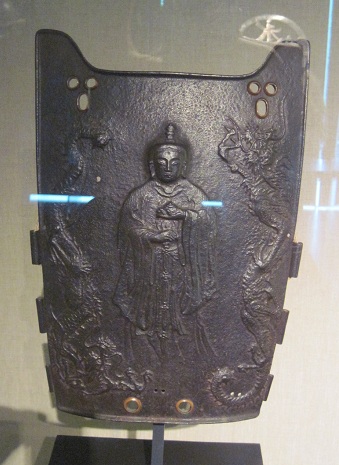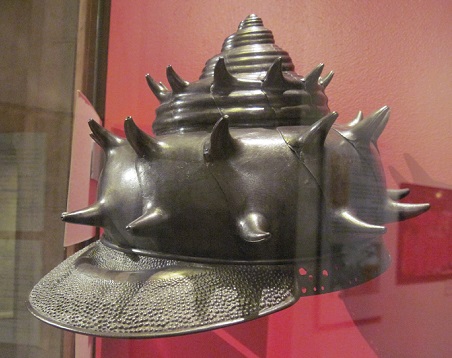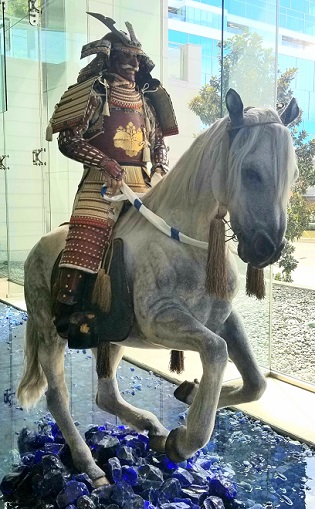Subject: hatamoto samurai 'bannerman' warrior guard
Culture: Japanese
Setting: late Muromachi / Aizuchi-Momoyama, Japan 1544-1643
Object: tōsei gusoku armor
* Dallas Museum of Art
"Helmet (suji bachi)
Japan: end of Muromachi period, late 16th century
Russet iron, copper, shakudo, gold, lacing, and lacquered wood" ...
"Mask (mempo)
Japan: end of Muromachi period, late 16th century
Russet iron, copper, shakudo, gold, lacing, and lacquered wood" ...
* Dallas Museum of Art
"Suit of armor,
Japan: late Momoyama period -- early Edo period,
early 17th century
Lacquer, wood, iron, copper, precious metals, gilding, pigment, boar's hair, feathers, textiles, and paper ...
This elaborate suit of Japanese armor, reflecting fine craftwork made for the warrior class, is an example of the kind of armor worn by the figures in the pair of screens mounted nearby. The armor and weapons were made during the same time period as the screens. Like the screens, the armor is highly ornamental and theatrical.
* Metropolitan Museum of Art > Stone Gallery of Arms and Armor
"Helmet (Suji Kabuto)
Lacquered iron, silk, gilt copper
Momoyama period,
late 16th-early 17th century
The gilt copper badge on the turnbacks of the neck guard is that of one of the Shiraishi family, who served the Daté, daimyo of Sendai."
* Metropolitan Museum of Art > Stone Gallery of Arms and Armor
"Helmet (Zukinnari Kabuto)
Lacquered iron
Momoyama period,
16th century
The helmet is shaped like a hat (zukinnari) worn by old men. The ornament at the front is that of the Buddhist guardian figure Fudō Myō-ō."
* Hanwei
* Museum at the Fashion Institute of Technology > Love and War
* Hunterian Museum
"JAPANESE SAMURAI ARMOUR
In Japan, from about the 9th century AD onwards, the samurai formed an hereditary class of fighting men, owing allegiance to warlords. In the 13th century the privilege of bearing arms was restricted to the samurai who thus enjoyed a period of social and administrative superiority which lasted until the mid 19th century. The introduction of European methods of warfare signalled their demise.
* Harwood International > Samurai Collection
"Toppai kabuto (high-sided helmet) and mempō (half mask)
Late Momoyama period, late 16th century
Mask attributed to Myōchin School
Iron, wood, laquer, gold
5 lbs. ...
This helmet has a tall bowl made of six large iron plates, a shape influenced by Korean helmets. The heraldic family crests presented on the fukigaeshi (turned-back side plates thought to deflect arrows) belong to the Okubo family. The separate half mask (mempō) would have been held in place using cords from the helmet."
* Harwood International > Samurai Collection
"Frontal plate of a dō (chest armor)
Momoyama period,
second half of the 16th century
Iron ...
This chest plate created in embossed iron depicts the Buddhist deity Uhō-doji flanked by two dragons. Known for chasing away bad luck, the deity is the Buddhist interpretation of the Shinto sun goddess Amaterasu."
* Higgins Armory Museum > Scimitars to Samurai: Arms around the World
"Nagasone Tojiro Mitsumasa
Helmet in the form of a sea conch shell, 1618 Japan Iron with traces of lacquer Weight: 3 lb. 13 oz. ...
Late sixteenth-century warlords and powerful generals wore flamboyant 'extraordinary helmets' (kawari-kabuto) to distinguish themselves amidst uniformly armored footmen and brilliantly attired samurai. This masterpiece of metalwork must have belonged to one of the most important men in Japan at the time of the shogun Tokugawa Ieyasu. It was so greatly admired that several derivative copies were made during the 1600s. [Cf. http://www.ForensicFashion.com/files/1702JapaneseSamuraiArmorMet02.JPG / 1702 Edo samurai armor]
* Harwood International > Azure
"SUIT OF ARMOR AND SADDLE SET
SUIT OF ARMOR SIGNED MIOCHIN MUNEHARU Japan, 19th century in the style of the 16th century Iron, laquer, silver, gold, silk
BAGU (SADDLE) SET SIGNED NAGAMUNE Japan, 1675 Wood, laquer, gold, iron, silk
This armor would have been worn by a Japanese samurai warrior: A Buddhist deity in silver and gold overlay decorates the front. The face is protected by a menpo (half mask) made of lacquered iron with red lips and a hair moustache.
The wooden saddle is signed with the skilled maker's name, Nagamune, and dated in the seventh month of the year 1675. It is elegantly lacquered in black with a design of butterflies in gold. The shape of the stirrups with their broad flat base was designed to allow the rider to stand when fighting, particulary [SIC] when shooting with the bow. Samurai were skilled marksmen who lived by the bushido code of honor." ...



